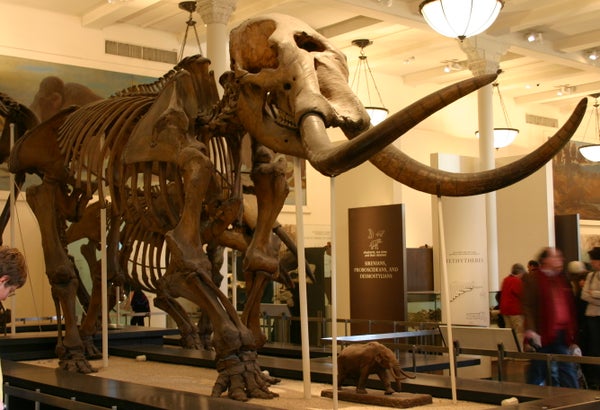This article was published in Scientific American’s former blog network and reflects the views of the author, not necessarily those of Scientific American
Sometimes the best parts of scientific conferences are the discussions that happen away from the public events. Doubly so when those discussions involve Ice Age coprolites.
Last month, while attending the Valley of the Mastodons conference at the Western Science Center, conversation inevitably turned to Mammut plops. I say inevitably because fossilized dung is a bonanza for paleontologists. It’s a confirmation of what animals ate and not just hypothesizing on the basis of tooth shape or wear facets. And in the case of the American mastodon, paleontologist Jeremy Green was saying, there’s a site rife with Pleistocene poop. Green was enthusiastic on this point. It wasn’t just a few isolated pats. This was a mastodon latrine.
Naturally, I had to get the reference. Thankfully Green had it on hand, and, after a little Google-fu, I was able to call it up. So let me tell you about what mastodons left behind.
On supporting science journalism
If you're enjoying this article, consider supporting our award-winning journalism by subscribing. By purchasing a subscription you are helping to ensure the future of impactful stories about the discoveries and ideas shaping our world today.
American mastodons were browsers. Even though there was some very early debate on this point – some 18th century naturalists thought that the Ice Age elephants’ massive, ridged molars indicated carnivorous habits – gut contents, microwear studies, geochemical signatures, and more have confirmed that a happy mastodon was one chawing a leafy tree branch. But it’s not enough to stop there. Mammut was not the same everywhere or at every time. Different populations undoubtedly selected different browse from the Ice Age salad bar presented to them. The treasure trove of mastodon coprolites found in Aucilla, Florida allowed paleontologists to narrow down the diet for at least one population of American mastodons.
The coprolitic riches were found at the Page-Ladson site in the Aucilla River. This isn’t your typical paleo site. It’s an inundated sinkhole that preserves a detailed record of life in the area from the Pleistocene to the present, including a time in Florida’s past when the climate was more arid and the local water levels were lower. The site's fossil record hints that it was a watering hole and wallow for local animals back in the Ice Age, and the copious amounts of mastodon dung found there support that interpretation.
There was so much dung that paleontologists didn't immediately recognize what they were looking at. Back in 1988, samples of the Pleistocene layers at the site revealed the presence of a “straw mat” of woody debris. Eventually, paleontologists realized that this straw had passed through the local mastodons. And there was a lot of it. Excavations in 1991 turned up a dung deposit about 29 meters square.

A diver holds up a "bolus of digesta" at the Aucilla site. Credit: Newsom and Mihlbachler 2006
That’s probably not all, as paleontologists Lee Newson and Matthew Mihlbachler pointed out in their analysis of the ancient spoils. “We estimate [the dung deposit] may originally have been hundreds of cubic meters in volume, filling a large portion of the entire sinkhole basin.” This was not the remnant of a local flood or other disaster. The twigs and plant debris were shredded, pinched, and mashed, just like plant material found in the guts of mastodons elsewhere. Other animals that lived in ancient Aucilla – like tapirs and giant ground sloths – could have made their own additions to the pile, but the bulk of the evidence suggests mastodons as the primary contributors.
So what do the Pleistocene pats tell us? First, the rough composition of the dung is quite similar to that of living elephants. That’s what allowed Newson and Mihlbachler to rule out some of the other possible contributors. The researchers also found at least 57 different plant taxa in the dung deposit, from conifer cones and wild plum to ash and pokeweed. Overall, though, the plant profile suggests that the mastodons were feeding in the wetland environment around the sinkhole in forests dominated by cypress, and that they were doing so from late summer through the fall.
Despite the diversity of plants in the dung deposits, though, the mastodons spent a great deal of time chewing twigs. “The abundant twig component of the dung deposits typically comprises upwards of 98% of the mass of individual dung samples,” Newson and Mihlbachler write, and most of that material is from cypress, bald cypress, and pond cypress, with twigs of buttonbush, willow, and other remnants of woody plants mixed in. And while this evidence comes to us as a massive, mixed deposit, Newson and Mihlbachler point out that this may actually provide a better view of what the local mastodons were eating than an individual pat. “The Aucilla River deposits containing heavy concentrations of dung may be more indicative of the general diet of the local mastodon population, including individuals of all ages and both sexes, rather than the diet of a single individual.”
But no Mammut mess stands alone. Skeletal evidence has already indicated that the mastodons from Aucilla were not the same as those in other parts of the country. Their diet and habits can’t be taken as a given for the entire species, especially since it highlights the fact that American mastodons enjoyed a diverse diet based on what was available. In short, we need more coprolites to get the poop on how mastodon populations differed from one another.
Reference:
Newsom, L., Mihlbachler, M. 2006. Mastodon (Mammut americanum) diet and foraging patterns based on analysis of dung deposits. First Floridians and Last Mastodons: The Page-Ladson Site in the Aucilla River. doi: 10.1007/978-1-4020-4694-0_10
